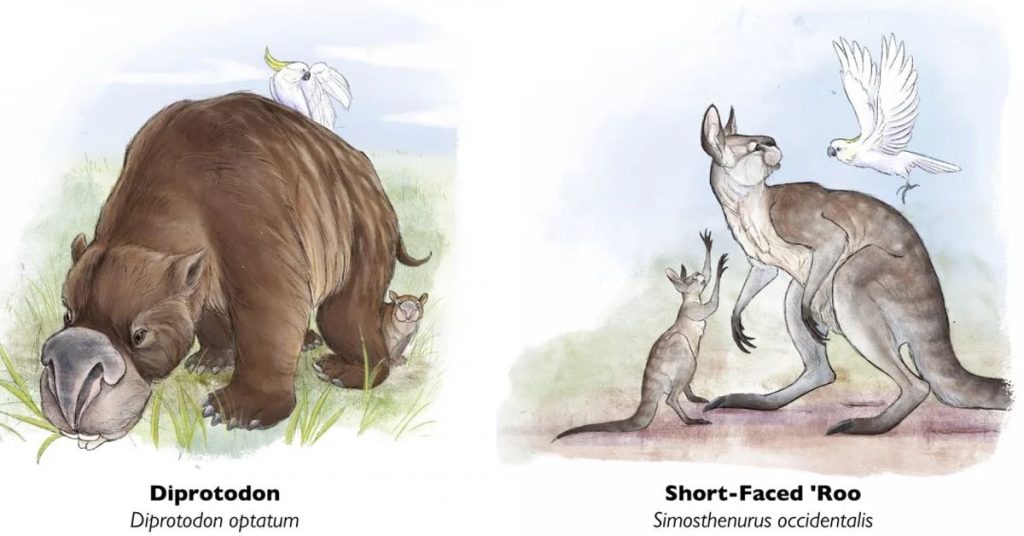Science – Extinct megafauna was vulnerable to ‘Hunger Games’

:quality(85)/cloudfront-us-east-1.images.arcpublishing.com/infobae/O7SY5LFNC5ELXJY6FUHGBPRE3A.jpg 992w)
Madrid 15 years (European press)
The combination of human hunting and climate change has led to the extinction of ‘giant’ species in Australia. For some, the change in food availability has made matters worse.
A sophisticated new model has revealed a previously unrecognized process that contributed to the demise of ancient megafauna communities in southeastern Australia tens of thousands of years ago — and for megaherbivores, it’s all about food.
Models of complex ecological networks developed by Australian and international researchers reveal how mega-herbivores in the Naracoorte region of southeastern South Australia were vulnerable to changes in the plants they fed. Change in food supplies driven by climate change or land use by humans in the late Pleistocene could have facilitated the extinction of the largest herbivores.
The research was led by scientists from the Australian Research Council’s Center of Excellence for Australian Biodiversity and Heritage (CABAH) at Flinders University. Modeling methods and analyzes are reported in an article in the scientific journal Ecography.
The Naracoorte Caves World Heritage area is known for its ancient megafauna fossils. However, while we know that animals like Diprotodon, which fed on giant wombat-like plants, roamed Australia and eventually became extinct, the set of events leading to their extinction varies across the continent. Therefore, there is still debate about the particular combination of environmental changes and responsible human hunting in a particular area.
To shed some ecological light on the problem, a team of ecologists, computer designers, and paleontologists from five universities used sophisticated mathematical techniques to build computer networks that represent the Narcourt ecosystem, from the plants to the invertebrates, plant eaters, and carnivores they identified. . ate to investigate why some species eventually die and others survive.
After determining how changes in the plant community spread across the network to affect larger herbivores, the scientists then built copies of the Naracoorte community network to test whether megafauna were more susceptible to falls. Extinct megafauna species occupied different positions in the network compared to species that have survived to the modern era.
“By modeling the ecological community using powerful computing methods, we can simulate the relative position of any extinct or modern species in the overall food chain as it has existed for thousands of years, and then estimate how vulnerable these species are to changes in the ecosystem.” Evolutionary ecologist and lead author at Flinders University Dr. John Llewellyn says in a statement.
“Our models revealed that extinct megafauna species, especially large herbivores, were more susceptible to these ‘bottom-up’ chains of co-extinctions caused by changes in plant species than species we still have today.”
The analyzes also showed that species lower in the food chain, such as herbivores that specialized in only a few plant species for food, were particularly vulnerable.
CABAH Senior Investigator and Principal Professor of Modeling Issues Cory Bradshaw of Flinders University says that despite decades of research trying to understand why Australia’s largest species went extinct, much of the environment in these communities has been overlooked.
Ecological network models are valuable tools for studying species interactions and examining how past extinction events evolved, as well as how extinction patterns might unfold in the future.
“Our methods have evolved significantly in recent years to be able to infer not only who may have eaten who in these long-lost communities, but also to provide new ecological insights into how successive extinctions occurred using modern computing power,” says the professor. Bradshaw.
“Like most environmental events, the reasons behind the major changes observed in the past, and those projected in the future, are complex and are rarely caused by individual disturbances. The disappearance of many of the world’s largest animals. Australia is no different in this respect.”

“Future teen idol. Hardcore twitter trailblazer. Infuriatingly humble travel evangelist.”




:quality(85)/cloudfront-us-east-1.images.arcpublishing.com/infobae/BNGH73UCKQAZSQPCODUWO2BE5Y.jpg)





